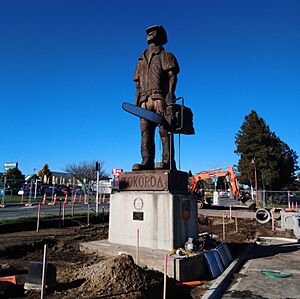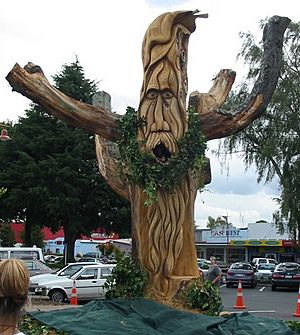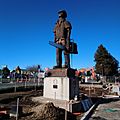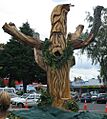Tokoroa facts for kids
Quick facts for kids
Tokoroa
|
|
|---|---|

Tokoroa in autumn (May 2012)
|
|
| Country | New Zealand |
| Region | Waikato Region |
| District | South Waikato District |
| Ward | Tokoroa Ward |
| Electorates |
|
| Area | |
| • Total | 15.65 km2 (6.04 sq mi) |
| Population
(June 2023)
|
|
| • Total | 14,500 |
| • Density | 927/km2 (2,400/sq mi) |
| Postcode(s) |
3420
|
Tokoroa is a town in the Waikato region of New Zealand's North Island. It is the fourth-largest town in the Waikato region and the biggest settlement in the South Waikato District. Tokoroa is located about 30 kilometers southwest of Rotorua and 20 kilometers south of Putāruru. It sits near the Mamaku Ranges and is halfway between Taupō and Hamilton on State Highway 1.
Contents
History and Culture
How Tokoroa Got Its Name
The name Tokoroa comes from a chief of the Ngāti Kahupungapunga people. He was defeated by the Raukawa people around the year 1600. This happened during a battle at Pōhaturoa, a large rock formation near Ātiamuri, which is south of today's Tokoroa. The name "Tokoroa" first appeared on maps in the 1860s, but it was for an area further away at that time.
How the Town Grew
Tokoroa is one of New Zealand's newer towns. It was started around 1917 by the Matarawa Land Company, who hoped it would be a good place for farming. A few families had already moved there after 1910, and a school opened in 1915.
At first, the land was not good for raising cows or sheep because of its pumice soil. Farmers found that their animals got "bush sickness." In the 1930s, scientists discovered this was due to a lack of cobalt in the soil. Once this problem was fixed, dairy farming became successful.
Between 1925 and 1935, Pinus radiata (pine trees) were planted for business. These trees grew well even with the soil problems. As the trees grew, Tokoroa became a home for workers of the Kinleith Mill. This large mill, owned by New Zealand Forest Products Limited, processes timber, pulp, and paper. It is about 8 kilometers south of the town.
In 1948, Tokoroa had 1,100 people. By the early 1970s, its population grew to over 20,000, which meant it could officially be called a city. However, in the 1980s, the Kinleith Mill started to reduce its operations. This, along with other local businesses closing, caused the town's population to drop. In 2018, about 14,300 people lived in Tokoroa.
Marae in Tokoroa
Tokoroa has two marae, which are important meeting places for Māori people. These marae are connected to local iwi (tribes) and hapū (sub-tribes):
- Ngātira Marae and its meeting house, Te Tikanga a Tāwhiao, are linked to the Ngāti Raukawa and Waikato Tainui tribes.
- Ōngāroto Marae and its meeting house, Whaita, are linked to the Ngāti Raukawa tribe.
In 2020, the government helped fund upgrades for Ngātira Marae and other marae in the area. This project also created jobs.
Geography
Where Tokoroa Is Located
Tokoroa is surrounded by many dairy farms and pine forests. There are also several beautiful nature reserves nearby. Lake Moananui, a man-made lake created in 1974/75, is part of a park where people can relax.
Tokoroa is in the middle of a triangle formed by popular tourist spots like Rotorua, Waitomo, and Taupō. There are also about 45 lakes for recreation within an hour's drive of the town.
Parts of the Town
The town has a main shopping area and several neighborhoods, which were built as the Kinleith Mill grew. These neighborhoods include:
- Parkdale
- Paraonui
- Papanui
- Matarawa
- Aotea
- Strathmore
- Amisfield
Many of the street names in Tokoroa were chosen by Sir David Henry (1888–1963), who was the first managing director of N.Z. Forest Products Ltd. He named them after places near his hometown of Edinburgh, in Scotland. David Henry Primary School is also named after him.
People in Tokoroa
Tokoroa covers about 15.65 square kilometers. In 2018, its population was 13,578. This was an increase of over 1,200 people since 2013.
The people in Tokoroa come from many different backgrounds:
About 13.3% of the people in Tokoroa were born overseas.
Climate
| Climate data for Tokoroa (Kinleith Mill), elevation 383 m (1,257 ft), (1981–2010 normals, extremes 1952–1990) | |||||||||||||
|---|---|---|---|---|---|---|---|---|---|---|---|---|---|
| Month | Jan | Feb | Mar | Apr | May | Jun | Jul | Aug | Sep | Oct | Nov | Dec | Year |
| Record high °C (°F) | 30.8 (87.4) |
30.5 (86.9) |
29.4 (84.9) |
25.7 (78.3) |
23.6 (74.5) |
17.9 (64.2) |
17.7 (63.9) |
19.1 (66.4) |
22.6 (72.7) |
23.9 (75.0) |
26.7 (80.1) |
29.3 (84.7) |
30.8 (87.4) |
| Mean daily maximum °C (°F) | 22.4 (72.3) |
22.5 (72.5) |
20.4 (68.7) |
17.3 (63.1) |
14.3 (57.7) |
11.7 (53.1) |
11.2 (52.2) |
12.2 (54.0) |
14.2 (57.6) |
16.0 (60.8) |
18.5 (65.3) |
20.7 (69.3) |
16.8 (62.2) |
| Daily mean °C (°F) | 17.2 (63.0) |
17.4 (63.3) |
15.4 (59.7) |
12.6 (54.7) |
10.3 (50.5) |
7.8 (46.0) |
7.1 (44.8) |
8.0 (46.4) |
9.9 (49.8) |
11.6 (52.9) |
13.6 (56.5) |
15.8 (60.4) |
12.2 (54.0) |
| Mean daily minimum °C (°F) | 12.0 (53.6) |
12.3 (54.1) |
10.4 (50.7) |
8.0 (46.4) |
6.2 (43.2) |
3.9 (39.0) |
2.9 (37.2) |
3.7 (38.7) |
5.6 (42.1) |
7.3 (45.1) |
8.7 (47.7) |
10.9 (51.6) |
7.7 (45.8) |
| Record low °C (°F) | 0.2 (32.4) |
1.4 (34.5) |
−1.3 (29.7) |
−2.6 (27.3) |
−5.3 (22.5) |
−6.7 (19.9) |
−7.0 (19.4) |
−5.5 (22.1) |
−4.8 (23.4) |
−4.4 (24.1) |
−1.8 (28.8) |
−1.1 (30.0) |
−7.0 (19.4) |
| Average rainfall mm (inches) | 112.1 (4.41) |
97.8 (3.85) |
105.3 (4.15) |
101.6 (4.00) |
141.7 (5.58) |
144.8 (5.70) |
147.9 (5.82) |
141.7 (5.58) |
149.4 (5.88) |
154.5 (6.08) |
120.3 (4.74) |
154.3 (6.07) |
1,571.4 (61.86) |
| Source: NIWA (rain 1971–2000) | |||||||||||||
Economy
The main industries in Tokoroa are forestry and dairy farming. The nearby Kinleith Mill is very important for forestry. In 1995, Fonterra built a very large cheese factory in Lichfield, just north of Tokoroa. Over the years, some forest land has been turned into farmland for dairy cows.
While forestry is still the biggest industry, much of the raw timber is now shipped overseas instead of being fully processed at Kinleith. Most of the Kinleith workers live in Tokoroa. The town also serves as a center for agriculture and other related businesses. These include making cheese, wooden boxes, and doing general engineering.
Even though timber and farming are key, many big shops have invested in Tokoroa. For example, a new New World (supermarket) opened on the main street. Also, Countdown (supermarket) built New Zealand's first supermarket with signs in both English and Te Reo Māori.
Education
Tokoroa has places for higher education, like Te Wānanga o Aotearoa and Toi Ohomai Institute of Technology.
The town has two high schools:
- Tokoroa High School
- Forest View High School
There are also special learning centers for secondary students who learn better outside a regular classroom.
Tokoroa has three primary schools that teach students from Year 1 to Year 8:
- Amisfield School
- Tainui Full Primary School
- Te Kura Kaupapa Māori o Te Hiringa (a Māori language immersion school)
There is one intermediate school:
- Tokoroa Intermediate
Tokoroa also has several primary schools for students from Year 1 to Year 6:
- Bishop Edward Gaines Catholic School
- Cargill Open Plan School
- David Henry School
- Strathmore School
- Tokoroa Central School
- Tokoroa North School
Some schools, like Matarawa Primary School and Tokoroa East School, have closed over the years.
Town Facilities and Attractions
Tokoroa offers several interesting places for visitors and useful facilities for its residents.
Talking Poles
Since 1997, Tokoroa has become famous for its "Talking Poles." These are sculptures, often carvings, that tell stories about the town's different cultures, sports, and industries. One famous carving, the Greenman, was made from a cedar tree in 2004.
By 2008, there were 42 Talking Poles around the town. A special event called the Tokoroa Talking Poles symposium happens every two years. Some poles have been moved to a central area to create a new display. The Greenman carving was moved in 2018 and is being restored.
Lake Moana-Nui
Lake Moana-Nui is a man-made lake in Tokoroa, built in the late 1970s for the community to enjoy. In the past, it was a popular spot for swimming, and locals even called it "Tokoroa Beach."
Over time, the lake had problems with weeds and poor water flow, making it unsafe for swimming. However, the lake has recently undergone a big cleaning and restoration project. It has been fully drained, refilled, and is now safe for public recreation again, just like it was in the 1970s and 80s.
Around the lake, you'll find picnic tables and four playgrounds. At the southern end, there are gardens planted by children from Tokoroa schools.
Tokoroa Airfield
Tokoroa has an airfield with a sealed runway that is 850 meters long. There are no regular flights, but the airfield is sometimes used for other activities.
Town Library
The Tokoroa library is in a building that used to be the town's cinema. It has many books, a computer area, and a special section for children. It is located in the center of Tokoroa.
Tokoroa Hospital
Tokoroa Hospital provides medical services for the people in the South Waikato District. It has 21 beds, including a ward for patients and a maternity ward for new mothers. There's also an emergency department and a surgery room for smaller operations. Other services include X-ray, lab tests, and a cafe. The hospital also has a helipad for transferring patients. Many other health services, like nursing, therapy, and social work, are based at the hospital site. Since 2014, the town's doctor's offices and a pharmacy have also moved to a modern health campus at the hospital.
Culture and Sports
Tokoroa hosts many sports, cultural, and music events each year, including the Polynesian Festival.
Polynesian Festival
The Tokoroa Polynesian Festival happens every September. Local schools and preschools perform Samoan, Māori, and Cook Islands dances and music. You can hear Cook Island drumming and see Māori performing arts on the stage at the South Waikato Events Centre.
Sports
Tokoroa is part of the Waikato Province for rugby, which means it's connected to the Waikato ITM Cup team and the Chiefs Super Rugby team. Netball teams in the South Waikato district are also part of the Waikato/BOP Magic franchise for the ANZ Championship.
For many years, Tokoroa has been known for its strong woodchopping and sawing competitions. These events, which include axe, long saw, and chainsaw contests, have always been a big part of the town's timber culture.
Tokoroa Memorial Sports Ground
The Memorial Sports Ground is used often for sports. It has:
- Eight netball courts
- Eight tennis courts
- Three rugby fields
- Eight touch rugby or rugby league fields
- One soccer field
- One rugby union club, the Southern United Rugby Football Club (SURF)
Y.M.C.A Sports Centre
The Tokoroa Y.M.C.A offers many indoor and outdoor activities, such as:
- Indoor skating
- Outdoor archery
- Indoor and outdoor soccer
- Basketball
- Netball
- Volleyball
- Indoor hockey
- Dance classes
Governance
The South Waikato District Council manages local services and facilities in Tokoroa. Their main office is located in the town. Tokoroa is part of the Taupō electorate, and its Member of Parliament (MP) has been Louise Upston since 2008.
Transportation
Cycling
Tokoroa has several cycleways that connect the town center to its different neighborhoods. These include special bike lanes and paths for both cycling and walking. There is a long cycleway from Browning Street that goes to Kinleith, offering views of the town and the mill.
Main Roads and Buses
New Zealand's main highway, State Highway 1, runs along the eastern side of Tokoroa. You can also reach Tokoroa from the southwest using State Highway 32. Tokoroa is known for not having any traffic lights.
National bus services like Intercity (New Zealand) also stop in Tokoroa, traveling along State Highway 1.
Public Transport
The Tokoroa Urban Connector bus service started in 2015. It runs a loop around Tokoroa and also connects to nearby towns like Tīrau, Putāruru, and Litchfield. In 2022, the service was renamed South Waikato Urban Connector. There are also bus services twice a week connecting Tokoroa to Taupō.
Railway
The Kinleith Branch railway line goes through Tokoroa. It connects Waharoa to the Kinleith Mill, south of the town. Most freight trains on this line carry goods between Kinleith and the Port of Tauranga. The line was rebuilt in 1952 and has only carried freight since then. A special terminal for containers opened in 2015.
Old Railways
In the early 1900s, the Taupo Totara Timber Company (TTT) built a 51-mile (82 km) railway. It ran between their sawmilling center at Mokai (near Taupō) and Putāruru, where it connected to the main New Zealand railway. This TTT line passed through the area where Tokoroa is now.
The TTT railway opened in 1905. It carried TTT staff, their families, and goods. From 1908, it also carried freight and passengers for the public.
Later, the New Zealand Government bought a 19-mile (31 km) section of the TTT Railway, from Putāruru to near the Kinleith Paper Mill. In 1947, the government took over this part of the line. It was rebuilt and finished in 1952.
The main goods carried from Kinleith used to be pulp, paper, plywood, and timber. Now, with changes at Kinleith, the main cargo is raw logs. These logs are sent overseas to be processed into timber, pulp, and paper in other countries. About 46 trains travel on this line each week.
Radio Stations
Tokoroa has several local radio stations:
- Raukawa FM 90.9/95.7 MHz
- Cruise FM 94.1 MHz (also in Mangakino-Whakamaru 104.4 MHz and Putaruru 107.7 MHz)
- Vision FM 88.5 MHz
- FRESH FM 88.3 MHz
You can also listen to national radio stations through local repeaters:
- Radio New Zealand National 729 kHz/101.3 MHz
- Newstalk ZB 1413 kHz
- Radio Rhema 99.7 MHz
- The Hits 97.3 MHz
Notable People
Many well-known people have connections to Tokoroa:
- Isaac Boss – a rugby union player for Ireland.
- Pero Cameron – a New Zealand basketball player and coach.
- Adrian Cashmore – a former All Blacks rugby player.
- Quade Cooper – an Australian rugby union player.
- John Davies – an Olympic bronze medalist in running.
- Stella Duffy – a novelist.
- Ben Hana – known as "Blanket Man" in Wellington.
- Tommy Hayes – a rugby union player for the Cook Islands.
- Isaac John – a rugby league player for New Zealand and the Cook Islands.
- Richard Kahui – a former All Blacks rugby player.
- Bob Kerr – an author, artist, and illustrator.
- Paul Koteka – a former All Blacks rugby player.
- Nicky Little – a rugby union player for Fiji.
- Walter Little – a former All Blacks rugby player.
- Kendrick Lynn – a rugby union player.
- Sean Maitland – a rugby union player for Scotland.
- Joseph Manu – a rugby league player for the Sydney Roosters and Junior Kiwis.
- Keven Mealamu – a former All Blacks rugby player.
- Jenny Morris – a New Zealand/Australian singer and songwriter.
- Henry Paul – a New Zealand rugby league player.
- Robbie Paul – a New Zealand rugby league player.
- Jordan Rakei – a neo-soul singer.
- The Politicians – a rock/new wave/reggae band.
- Sir Paul Reeves – a former Governor-General of New Zealand.
- Dallas Seymour – a former All Black rugby player.
- Bruce Simpson – a blogger and jet-engine experimenter.
- Brian Tamaki – the founder of Destiny Church.
- Zane Tetevano – a rugby league player for the Sydney Roosters and the Cook Islands.
- Maria Tutaia – a New Zealand netball player.
- Monique Williams – a New Zealand sprinter.
- Royce Willis – a former All Blacks rugby player.
- Tamatha Paul – a Member of Parliament for the Green Party.
Images for kids





